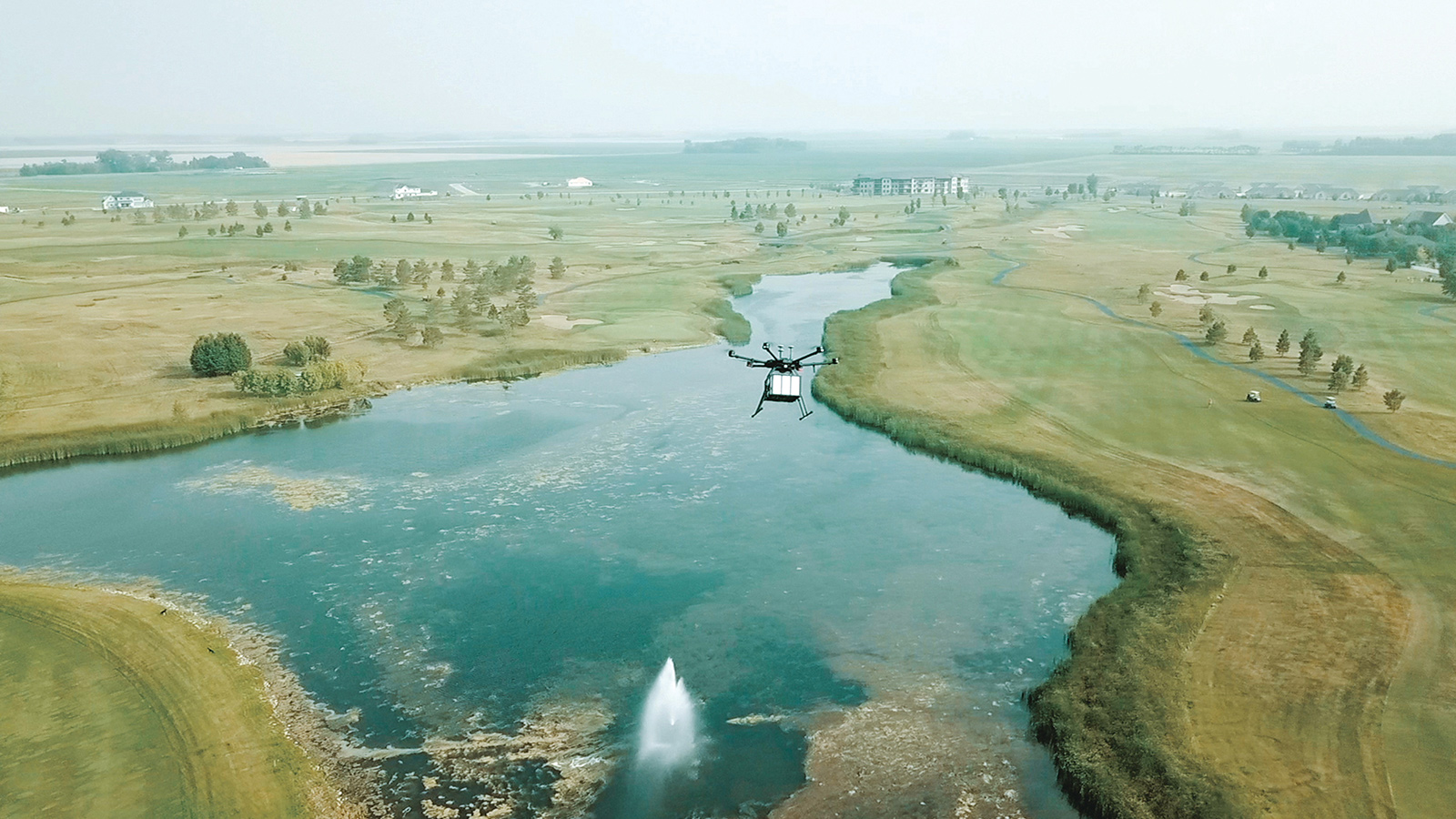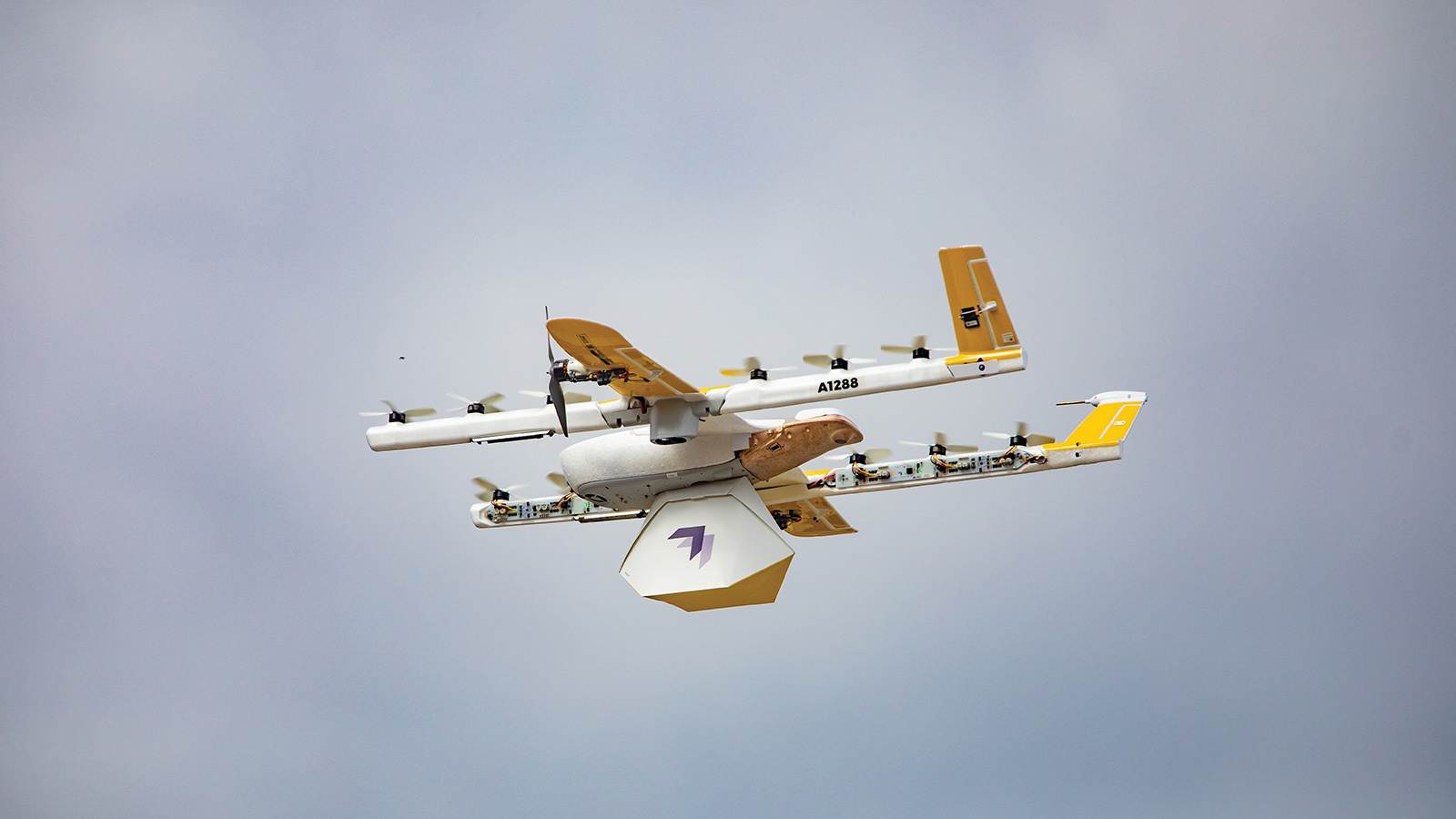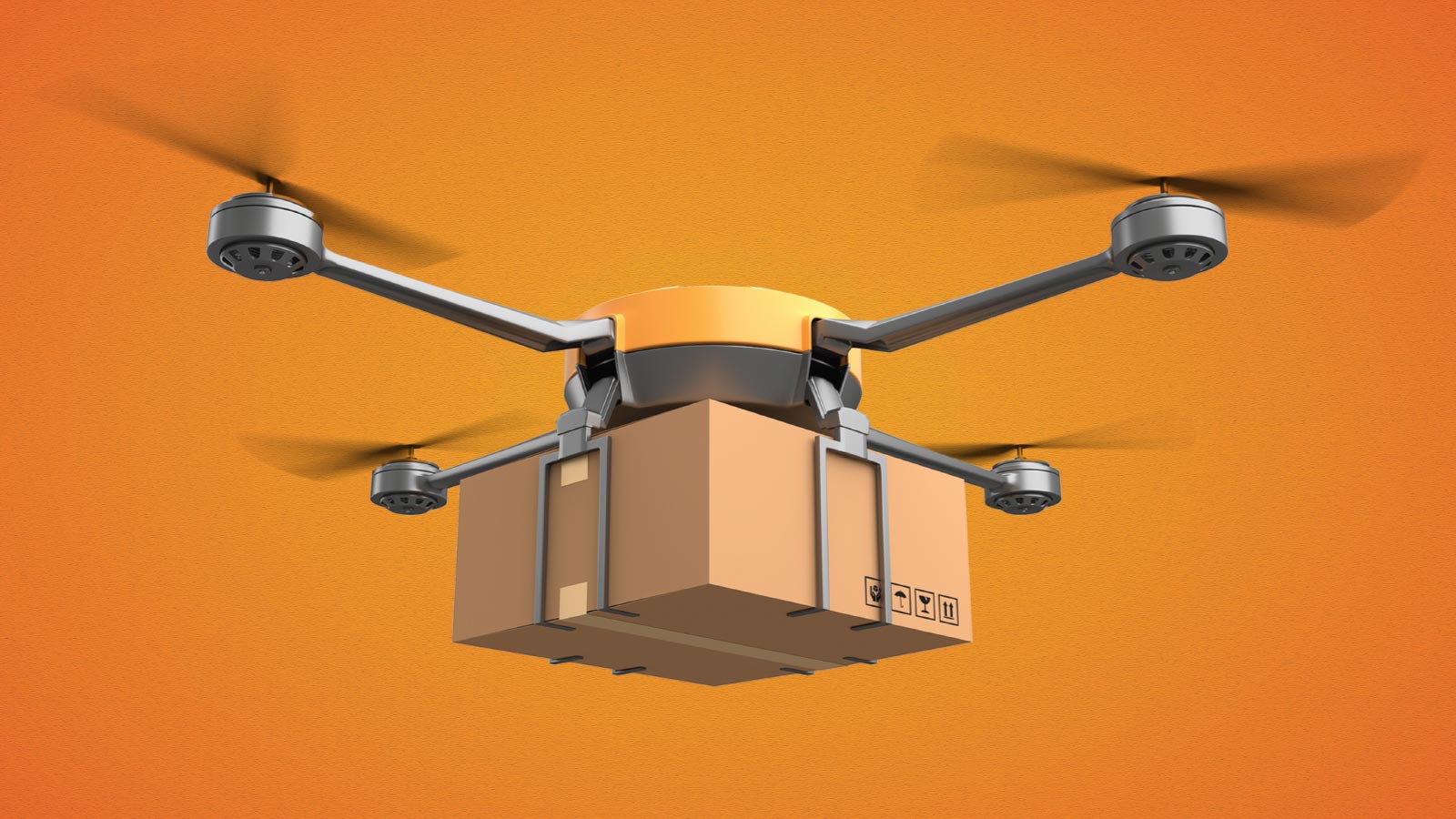Stay Up to Date
Submit your email address to receive the latest industry and Aerospace America news.
The fact that the skies aren’t yet filled with delivery drones is deceiving. The revolution has been slow in coming, but in a few places, it’s beginning to happen. Daniel Dubno explores the path ahead for delivery entrepreneurs.
Drone delivery to consumers once seemed like pie in the sky. Good news: Drones now deliver pie from the sky. Unfortunately, this service only flies to some fjords near Reykjavik during the relatively placid summer months, and the only available pie flavor, I’m told, is rhubarb. To be fair, a wide assortment of other food choices is available for drone delivery from AHA, Iceland’s largest e-commerce website, which in 2017 began delivering pies, burgers, beer, pizza, snacks and such via drones supplied by Tel Aviv, Israel-based Flytrex corporation.
Food isn’t the only thing coming from the skies. Last October, drones delivered non-prescription drugs and gift items to customers in Christiansburg, Virginia, through a consortium whose members include drone development company Wing (a spinoff from Google’s “X” research group), FedEx Express and Walgreens. Just days later, in November, United Parcel Service’s Flight Forward drone division and San Francisco-based drone manufacturer and delivery company Matternet flew prescriptions from a CVS store in Cary, North Carolina, to nearby customers too sick to travel to the pharmacy. A few kilometers away, in Raleigh, North Carolina, lifesaving blood and medical supplies now routinely wing their way across the campus of WakeMed Hospital. Drone delivery services have also sprouted up in Australia, China, Finland, Ghana, Rwanda, Switzerland and the United Kingdom.
Yet when you hear rotor blades humming, do not assume the rotors beating beat for you. At least, not yet. What unites these delivery services is that each is either a test or a limited initial commercial service approved under conditions carefully proscribed by aviation regulators. The U.S. is a particularly sought-after market due to its strong consumer culture, but visions of drones plying the skies like FedEx or UPS trucks remains a lofty goal.
The barriers to routine deliveries in the U.S. are complex but can be summarized simply. “First, safety has to be the priority, and second, the interaction with the public and public acceptance has to be positive,” says Mark Blanks, who directs the Virginia Tech Mid-Atlantic Aviation Partnership. Virginia Tech is a collaborator within the state of Virginia’s experimental drone delivery test effort, approved by the FAA, that includes Wing, FedEx Express, Walgreens and others.
Now, after a slow start and a nudge from Congress, the FAA is working side by side with drone makers, delivery companies and NASA technologists to assure that these aircraft won’t pose unacceptable risks to the public, whether they be on the ground or aboard other aircraft flying at low altitudes.
Taming the “Wild West”
In a memorable appearance on “60 Minutes” in 2013, Amazon CEO Jeff Bezos predicted that autonomous deliveries were probably “four or five years away.” He allowed the public to see several drone delivery prototypes in flight and confidently envisioned that legions of drones would soon whisk Amazon packages through the skies. Bezos was right about the timing of the first test deliveries but was overly optimistic about when drone deliveries would become widespread in the United States. Bezos’ genius for predicting future trends did not help him foresee challenges autonomous delivery drones would create for government regulators.
Consider the 2016 Consumer Electronics Show in Las Vegas that I attended. The lower-floor convention hall overflowed with every imaginable variation of drone design, including some to carry packages for the exploding web economy. Amid this hubbub of whizzing rotors, the small section where the FAA had set up an information zone in the Las Vegas convention hall was conspicuously quiet. The electronics industry was selling a drone-filled “Wild West,” but few flocked to the FAA booth for advice, and the government sheriffs of air safety showed little outward evidence of being swept up by the fervor and emotion of it all.
Behind the scenes, however, the FAA was being pressured to solve some tricky problems. Four years earlier, influence from drone operators had led Congress to pass the FAA Modernization and Reform Act of 2012 (signed by President Barack Obama) that instructed the FAA to establish regulations to permit commercial drone flights. One problem was that these craft tend to be larger than consumer drones, making them potentially lethal. The FAA had to figure out how to deconflict thousands of future flights to avoid collision and catastrophe. A particular worry was that delivery drones might crash into each other or other low-flying aircraft, such as tour helicopters, crop dusters or airplanes taking off or landing.
In February 2016, a month after that CES show, additional pressure from companies including Amazon and Google led the FAA to draft guidelines for regulating safe commercial drone flights above populated areas. During the summer of that year, the FAA released Part 107 of the Federal Aviation Regulations, which established rules for operating nonhobbyist drones weighing less than 55 pounds (25 kilograms). Flights were limited to daylight or twilight hours in the visual line of sight of an operator and no higher than 400 feet, but the rules also provided an opening for the drone visionaries. The FAA pointed out to me that these rules continue to provide “flexibility for the FAA, at its discretion, to waive some limitations.” In fact, the agency has pages and pages of waivers, including approvals for police departments and film crews to fly at night with ground observations over specific areas.
Nevertheless, the limits ruled out an immediate explosion of services like those envisioned by Bezos and others. To give the sector a boost, the Trump White House in 2017 issued a memorandum to Transportation Secretary Elaine Chao instructing the FAA to establish Unmanned Aircraft Systems Integration Pilot Programs. Participants in these IPPs are making limited commercial test deliveries and other flights at sites across the United States. Initially, 10 regional IPPs were selected, comprised of state agencies, drone manufacturers, flight companies and other businesses. One IPP consortium dropped out, leaving nine programs. Flytrex, participating in North Carolina’s IPP, estimates it will deliver takeout food by drone beginning in the first few months of 2020, within the suburb of Holly Springs.
Failing safely
Regulators have been concerned about what would happen if a drone’s battery failed in flight or the craft experienced a catastrophic loss of control or a package came untethered. A commercial delivery drone weighing up to 25 kilograms and falling from hundreds of feet would likely damage property and possibly injure or kill people. Even a small package from a significant height could be lethal. Six years ago, in Jersey City, New Jersey, a construction worker’s tape-measure weighing just half a kilogram reportedly fell from 500 feet and killed a person standing underneath.
Commercial drone manufacturers developed redundant batteries, installed multiple navigation computer sensors and control chips, and designed software to detect failure and make the craft automatically land safely in such circumstances. For its delivery service, Flytrex modifies commercial DJI Matrice 600 Pro drones, originally designed for aerial photography. Although the top-of-the-line drone already incorporates a wide range of safety technologies, Flytrex customized an automatic parachute as well. Though eager to keep details from competitors, Flytrex’s co-founder Yariv Bash says, “Our independent system identifies when the drone is flipping or falling and then cuts off the motors and ejects the parachute.”
Beginning in 2003, and throughout the evolution of commercial delivery drone design, standards organization ASTM International’s Committee on Unmanned Aircraft Systems suggests safety technologies for delivery drones. They include software, control systems, battery designs, manufacturing methods and parachute safety mechanisms that experts from the standards group believe should be on such drones. Bash says the specter of delivery drones falling from the sky needs to be placed in perspective. “Remember that any alternative, which usually includes a human driving a 1-ton car, is much more dangerous,” he says.
Perfection is no more possible for drone deliveries than in other forms of air travel. In at least one case, another parachute design did not work as planned. Last May, a 22-kg Matternet delivery drone, operated by Swiss Post, crashed 50 meters from a group of children in a wooded area of Zurich, after reportedly having been buffeted by wind gusts. Swiss Post, the national postal service, which was routinely delivering medical supplies by drone, temporarily suspended the service after the failure, although no injuries were reported. An investigation determined the parachute failed as it was deployed when a connecting rope was severed. Future Matternet drones, according to media reports, will be securely connected to their parachute by two ropes reinforced with metal braiding. The drone’s existing emergency landing whistle will also be made louder.
Exploding demand
The drone tidal wave is building. The FAA has so far registered about 1.5 million small unmanned aircraft, including some delivery drones, an FAA official tells me, and demand is building for even more aircraft. Each of these drones must give other aircraft wide berth, avoid private planes, low-flying gliders, free-flying balloons and erratic medevac operations.
Given the expected volume of flights, automated management will be essential. The FAA devised an early version of such an automated management strategy to cope with the many requests to permit commercial drones, and now also recreational drones, to fly in the controlled airspace near 600 airports. The core of the strategy is the Low Altitude Authorization and Notification Capability, an online portal backed by computers and software that authorizes or rejects a requested route in seconds. Those requests don’t go directly to LAANC (pronounced “lance”) or the FAA, however. A drone operator logs onto an app provided by one of 13 unmanned aircraft service suppliers, which are companies authorized by the FAA to manage requests that are analyzed by the LAANC computers. Drone operators, the FAA and others can also see real-time flight tracks displayed on these apps.
Beyond the drone realm, the FAA is shifting to a next-generation air traffic control strategy of computerized guidance that will permit controllers to reduce separation among passenger and commercial aircraft in the air and on the ground. Drones, however, won’t get that same human touch as the FAA expands LAANC and what the agency calls a “complementary” concept known as UTM, short for Unmanned Aircraft Systems Traffic Management. NASA’s Ames Research Center in Silicon Valley is developing a research version of UTM for the FAA to demonstrate automatic management of drone flights beyond visual line of sight or in airspace outside the purview of air traffic controllers. UTM also will rely on private service suppliers under a business plan to be decided.
Ron Johnson, project manager at Ames, suggests that UTM drone operations could someday incorporate “localized weather predictions into flight planning, using cellphone networks to enhance drone traffic communications, relying on cameras, radar and other ways of seeing” to ensure drones fly safely.
For UTM to work, drone operators and the FAA need to know who is flying where. One reason is deconfliction, but the FAA also wants to distinguish “good drones” from “bad drones,” one FAA official says, referring to the possibility of a drone controlled by terrorists attempting to deliver bombs or toxins. This led the FAA to release a proposed rule in December that would require drones to transmit their unique serial numbers and locations with a time stamp over the internet from takeoff through landing. Under this Remote ID rule, a separate category of Remote ID service suppliers authorized by the FAA would receive this flight data in real time from subscribing drone operators.
The FAA is receiving pushback to this proposed rule and as of late January had received 6,000 comments during the public response period that runs through March 2, an FAA official says. The FAA official notes that public input prompted changes to Part 107 when it was proposed, suggesting that a final Remote ID rule might look quite different.
The FAA drafted the rule recognizing that privacy would be an issue. If an operator wanted to keep a customer’s flight confidential, the service supplier would generate a random code to conceal the aircraft’s identity to all but the FAA and law enforcement authorities. Data privacy is a related concern, because the service suppliers would be required to store drone flight data for six months in case authorities need to review it to hold a reckless drone operator accountable.
The expense of internet connectivity is another issue. DJI, the world’s largest consumer drone maker, in January published a critique on its website, saying the FAA “has proposed a complex, expensive, and intrusive system.” DJI wants the FAA to shift to requiring radio broadcasts from the drones, saying this technology would be “cost-free and easy-to-use.”
For these and other reasons, drone delivery has rolled out more slowly than the visionaries hoped. Looking out my Manhattan window right now, not a single drone is in sight. But the evidence shows that this revolution is indeed coming.
When I was young, we waited sometimes for hours on the beach in Coney Island for the Good Humor man. Eventually, you would see him lug a box of ice cream bars across the sand and he would deliver joy. There is a sunny day coming, when someone on the beach will say, “Kids, look to the sky!” Down a line will come bars of ice cream and perhaps, for me, a banana split with three scoops, whipped cream, strawberry syrup, just like I ordered it. Plus, a spoon.
“First, safety has to be the priority, and second, the interaction with the public and public acceptance has to be positive.”
Mark Blanks, Virginia Tech Mid-Atlantic Aviation Partnership
About Daniel Dubno
Dan is an Emmy Award-winning broadcast journalist, technology writer and science historian. He’s reported on aviation, aeronautics and remote sensing for four decades.
Related Posts
Stay Up to Date
Submit your email address to receive the latest industry and Aerospace America news.









